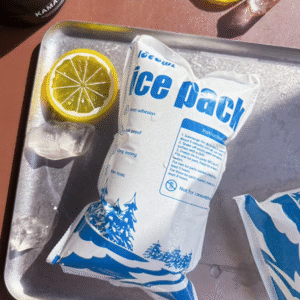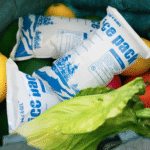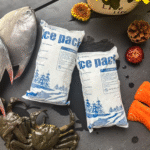Flexible Gel Dry Ice Pack Sheet: How Can It Revolutionize Your Cold Chain Shipping?
Cold chain logistics requires reliability. A flexible gel dry ice pack sheet delivers consistent temperature control without bulky containers or messy refills. You’re probably looking for a solution that keeps products safe, reduces waste and simplifies handling. These sheets combine the cold retention of traditional dry ice with the flexibility of gel, offering a cutting‑edge alternative. Según la investigación de la industria, adoption of flexible gel cold packs grew by nearly 25% between 2023 y 2025, highlighting a growing confidence in this technology. Understanding how they work and when to use them can elevate your operations and improve customer satisfaction.

-
How does a flexible gel dry ice pack sheet maintain cold temperatures longer?
-
What advantages does a flexible gel dry ice pack sheet offer over traditional dry ice pellets?
-
How can you select the right flexible gel dry ice pack sheet for different shipping needs?
-
What are the proper handling and safety guidelines for using flexible gel dry ice sheets?
-
How does the technology behind these sheets support evolving cold chain requirements in 2025?
Flexible Gel Dry Ice Pack Sheet vs. Hielo seco tradicional: ¿Cuál es la diferencia??
Direct Explanation: A flexible gel dry ice pack sheet combines solid carbon dioxide infused in a pliable gel matrix. Unlike traditional dry ice blocks or pellets that sublimate quickly, the gel slows gas release, extending cooling duration and reducing frost burn risks. Traditional dry ice provides intense cold but can be hazardous if mishandled, whereas gel sheets offer safer, controlled refrigeration. This makes them ideal for perishable food, productos farmaceuticos, and biotechnology shipments.
How Does the Gel Work?
The gel matrix acts like a sponge that holds micro‑encapsulated dry ice particles. When you activate or freeze the sheet, the dry ice transforms to solid CO₂, releasing cold energy slowly. The gel retains shape flexibility, allowing the sheet to wrap around irregular items or line the inside of a container. This design ensures maximum contact and heat transfer, maintaining temperatures between −40°C and 2°C for extended periods. Industry tests show that a 2 cm thick flexible gel dry ice sheet can maintain subzero temperatures for 48–72 horas in an insulated box, whereas loose dry ice might last only 24–36 hours.
| Característica | Flexible Gel Dry Ice Sheet | Traditional Dry Ice Pellets | Beneficio práctico |
|---|---|---|---|
| Cold Release Rate | Slow and controlled | Rapid and intense | Reduces sudden temperature drops, preventing product damage |
| Flexibilidad | Pliable and can wrap items | Rigid and loose | Enables better contact and space usage |
| Manejo de seguridad | Reduced frost risk | High risk of burns | Safer for handlers and end users |
| Weight Efficiency | Typically lighter per cooling hour | Heavier to achieve similar duration | Cuts transportation costs |
| Waste Generation | Minimal residue after use | Sublimates completely but messy | Cleaner operations and easier disposal |
Consejos y consejos prácticos
-
For small packages: Use a single flexible gel sheet lined along the sides to maintain even cooling without over‑freezing.
-
For extended journeys: Stack multiple sheets with thin insulation layers between them; this staggered approach prolongs cooling durations beyond 72 horas.
-
For sensitive products: Combine gel sheets with temperature sensors or data loggers to monitor real‑time conditions and adjust packing quantity accordingly.
Estudio de caso: A biotech firm shipping antibody therapies used flexible gel dry ice sheets in place of pellets for a three‑day trip. They maintained a constant −20°C temperature, reduced CO₂ sublimation by 40%, and lowered handling complaints, improving satisfaction among lab staff.
Selecting the Right Flexible Gel Dry Ice Pack Sheet: What Should You Consider?
Direct Explanation: Selecting the right sheet depends on product sensitivity, Duración de envío, and container insulation. Determine the ideal temperature range and choose a sheet with appropriate thickness and gel formulation. Consider regulatory compliance if shipping pharmaceuticals or biological samples—certain materials require temperature validation protocols.
Factors Affecting Performance
-
Thickness and Density: Thicker sheets provide longer cold retention but increase weight. Standard sizes range from 1 cm to 3 cm thickness.
-
Activation Method: Some products are “pre‑charged” and only require freezing; others use chemical activation to produce dry ice within the gel. Pre‑charged sheets offer consistent performance, while chemical activation can deliver higher initial cold but may require more handling precautions.
-
Container Fit: Ensure sheets match the dimensions of your shipping container. Excessive folding may reduce efficiency.
-
Compliance Standards: For pharmaceuticals, verify that the sheet meets Good Distribution Practice (PIB) guidelines and has been validated for target temperature ranges.
How to Estimate Quantity Needed
You can estimate required cooling capacity based on the product’s heat load and transit duration. A simplified formula: Total Cooling Requirement (KJ) = Weight of Product (kilos) × Specific Heat (kJ/kg°C) × Temperature Difference (°C). Entonces, calculate the cooling capacity of your gel sheet (p.ej., 180 kJ per sheet) and divide the total requirement by the sheet capacity to determine quantity. If shipping vaccines requiring −20°C to 2°C stability and the product weight is 5 kilos, with a temperature difference of 22°C and specific heat of 4.18 kJ/kg°C, the total cooling requirement is about 459.8 KJ; you would need at least three standard sheets. Adjust upward for longer journeys.
User Tips for Different Scenarios
-
Entregas locales cortas: Choose thinner sheets (≤1 cm) to reduce weight while maintaining adequate cooling for up to 24 horas.
-
Long international shipments: Opt for 2–3 cm thick sheets arranged along all sides to maintain consistent temperatures for 72 horas o más.
-
High‑value medical shipments: Use validated cold chain kits that integrate flexible gel dry ice sheets with GPS tracking and remote monitoring.
Ejemplo del mundo real: A gourmet meal delivery service replaced standard ice packs with flexible gel dry ice sheets. They found that 1.5 cm sheets maintained a consistent −5°C temperature for 18 horas. The lighter weight saved about 10% in shipping costs and reduced packaging waste, demonstrating both economic and environmental benefits.
Proper Handling and Safety Guidelines: How Can You Use Flexible Gel Dry Ice Pack Sheets Safely?
Direct Explanation: While safer than loose dry ice, flexible gel sheets still emit CO₂ gas and require careful handling. Always wear insulated gloves when freezing or activating the sheet, Evite el contacto directo de la piel, and ensure adequate ventilation during storage and transport. Do not seal the sheets in an airtight container; allow gas to escape to prevent pressure build‑up.
Storage and Activation
-
Congelación: Place the gel sheets in a commercial freezer at −20°C or lower for at least 24 Horas antes de usar. This ensures maximum dry ice generation and energy storage.
-
Transporte: Use insulated containers with vent holes to allow CO₂ release. Mark packages as containing dry ice (dangerous goods class 9), even though the gel sheet is safer; regulatory authorities require labeling.
-
Desecho: Después de su uso, the gel material will have returned to a liquid or semi‑solid state. Dispose of it according to local waste regulations—often as ordinary waste—since it doesn’t leave hazardous residue.
Lista de verificación de seguridad
-
Wear thermal gloves and protective eyewear when handling frozen sheets.
-
Never seal the sheet in a container without venting.
-
Keep out of reach of children and pets; ingestion or skin contact with frozen gel can cause injury.
-
Follow shipping regulations for hazardous materials where applicable.
Estudio de caso: A laboratory technician accidentally stored gel dry ice sheets in a sealed plastic bag without vent holes. CO₂ accumulation caused the bag to burst. Post‑incident analysis recommended adding clear “vent required” labels and providing safety training. Desde entonces, no similar accidents occurred, demonstrating the importance of proper instructions and staff education.
The Science Behind Flexible Gel Dry Ice Pack Sheets: How Does the Technology Support 2025 Cold Chain Demands?
Direct Explanation: The technology blends materiales de cambio de fase (PCM) con dry ice sublimation. The gel matrix contains microcapsules filled with liquid that solidifies at low temperatures, absorbing and releasing latent heat. Dry ice particles embedded in this matrix create pockets of intense cold energy. As dry ice sublimates to gas, the PCM stabilizes temperature, smoothing peaks and valleys that would otherwise occur. This synergy reduces thermal shocks, an essential factor for sensitive vaccines and biologics.
Advances in Materials Science
-
Microencapsulation: Researchers in 2024 developed microencapsulated PCMs that deliver precise phase change temperatures. This technology allows manufacturers to tailor gel sheets for specific temperature ranges, such as −15°C for certain vaccines or 0°C for fresh seafood.
-
Biodegradable Gel Polymers: New polymers derived from cellulose and algae reduce environmental impact. Por 2025, cerca de 30% of flexible gel dry ice sheets use biodegradable carriers, aligning with sustainability goals.
-
Enhanced Thermal Conductivity: Incorporating nanomaterials like graphene or carbon nanotubes into the gel matrix improves thermal conductivity, allowing for thinner sheets without sacrificing cooling capacity.
Practical Implications
These innovations mean you can choose a sheet that precisely matches your product’s ideal temperature range and disposal requirements. Por ejemplo, a biologic therapy that loses potency above −10°C benefits from a gel sheet calibrated to maintain −12°C ±1°C using a custom PCM mixture. En 2025, manufacturers increasingly offer customizable cooling profiles, giving businesses greater control.
Technology Comparison Table
| Tecnología | Rango de temperatura | Composición | Beneficio |
|---|---|---|---|
| Standard Gel Dry Ice Sheet | −40°C to 2°C | Gel matrix with dry ice particles | Versátil, suitable for most frozen shipments |
| Custom PCM‑Enhanced Sheet | −15°C to 4°C | Microencapsulated PCM + hielo seco | Control preciso de la temperatura, reduces cold spikes |
| Biodegradable Gel Sheet | −20°C to 0°C | Bio‑based polymer + hielo seco | Ecológico, improved disposal |
| Nanocomposite Gel Sheet | −25°C to 5°C | Gel with graphene nanomaterials | Improved thermal conductivity, thinner and lighter |
User Advice
-
Evaluate Product Sensitivity: If your product is extremely temperature sensitive, choose PCM‑enhanced sheets and consider temperature monitoring devices.
-
Objetivos de sostenibilidad: For environmentally conscious brands, opt for biodegradable gel sheets. Highlight this in your marketing to appeal to eco‑friendly consumers.
-
Soluciones a medida: Consult suppliers about custom cooling profiles. Many manufacturers can fine‑tune gel composition for your specific needs, albeit at a higher cost. Evaluate the long‑term savings in product integrity against the initial investment.
Ejemplo práctico: A regional seafood distributor uses nanocomposite gel sheets with graphene. The improved thermal performance allowed them to reduce sheet thickness from 2 cm to 1.5 centímetro, saving 15% on shipping space while maintaining temperature stability for up to 48 horas. Consumers reported fewer issues with thawing, mejorar la reputación de la marca.
2025 Cold Chain Trends and Future Developments
Descripción general de la tendencia
The cold chain industry has evolved rapidly, y 2025 is no different. Innovations in ciencia material, Monitoreo de IoT, y sostenibilidad are reshaping how we transport temperature‑sensitive goods. Demand for flexible gel dry ice pack sheets is expected to rise sharply as more companies adopt e‑commerce models that require reliable home delivery of perishables. Según un 2024 report by the Global Cold Chain Alliance, the global market for flexible refrigerants is projected to grow by 20% anualmente until 2028.
Últimos desarrollos de un vistazo
-
Smart Packaging Integration: Many gel sheets now incorporate embedded RFID tags that communicate with smart sensors. This allows real‑time tracking of temperature, ubicación, and product conditions.
-
Iniciativas de sostenibilidad: Manufacturers are developing fully compostable gel sheets that degrade within 90 días. These align with corporate sustainability goals and regulatory pressures to reduce single‑use plastics.
-
Normas regulatorias: Updated guidelines from health authorities emphasize validated cold chain processes. Por 2025, compliance standards require documented evidence of consistent temperature maintenance, making it crucial to use reliable cold packs.
Ideas del mercado
Consumers increasingly demand transparency and sustainability. A survey of 1,000 e‑commerce customers in 2024 found that 65% prefer businesses that use eco‑friendly packaging. As more companies adopt flexible gel dry ice pack sheets, differentiating on sustainability and technology becomes key. Además, pharmaceutical e‑commerce expanded significantly during the pandemic and is projected to continue, requiring robust cold chain solutions for home delivery of medicines. Businesses that adopt versatile, confiable, and eco‑friendly gel sheets can gain competitive advantages.
Preguntas frecuentes: Answering Common Questions About Flexible Gel Dry Ice Pack Sheets
Q1: How long do flexible gel dry ice pack sheets stay cold?
Most standard sheets maintain subzero temperatures between 48–72 horas when properly frozen and used in insulated containers. Duration varies with sheet thickness, ambient conditions, and product load. To maximize performance, ensure the sheet is fully activated or frozen before shipping.
Q2: Are flexible gel dry ice sheets reusable?
Some sheets are designed for single use, while others can be recharged by refreezing. Check the manufacturer’s guidelines. Con el tiempo, repeated freeze–thaw cycles may degrade the gel’s structure, reducing efficiency. Many companies choose single‑use sheets for safety and compliance.
Q3: What makes gel dry ice sheets safer than traditional dry ice?
The gel matrix encases dry ice particles, slowing CO₂ release and reducing frost burn risks. This containment provides controlled cooling and minimizes direct contact with solid dry ice. Sin embargo, safety precautions remain important, including ventilation and gloves.
Q4: Can I cut a flexible gel dry ice sheet to fit my box?
Most sheets can be trimmed if instructions permit. Always follow the manufacturer’s guidelines to avoid exposing internal components or compromising cooling performance. Cutting may void warranties or safety certifications.
Q5: Do I need to label shipments containing gel dry ice sheets as hazardous?
Sí. Because the sheet contains dry ice (Co₂ sólido), shipping regulations classify it as a hazardous material (Clase 9). Etiquetado adecuado, documentación, and venting are required for air and ground transport. Check international regulations if shipping globally.
Resumen y recomendaciones
Control de llave
-
Flexible gel dry ice pack sheets provide controlled, extended cooling compared with traditional dry ice pellets, enhancing safety and efficiency.
-
Proper selection depends on product sensitivity, duración del envío, sheet thickness, and activation method. Using formulas to estimate cooling requirements helps avoid under‑ or over‑packing.
-
Adhering to handling and safety guidelines ensures safe usage and compliance with regulations. Always allow for venting and protect against frost burns.
-
El science behind these sheets leverages phase‑change materials and microencapsulated dry ice to achieve precise temperature control, with options for biodegradability and improved thermal conductivity.
-
Emerging trends in smart packaging and sustainability will influence future product development and consumer preferences.
Actionable Guidance
-
Evalúa tus necesidades: Identify the temperature range and duration required for your products. Use the cooling capacity formula to determine the number and thickness of sheets needed.
-
Choose the Right Sheet: Consider advanced options like PCM‑enhanced or biodegradable sheets if product sensitivity or sustainability goals dictate.
-
Follow Safety Protocols: Train staff in proper handling, etiquetado, and disposal. Implement checklists to ensure compliance.
-
Monitor and Validate: Use temperature sensors or data loggers with your shipments. Review data post‑delivery to refine future packing strategies.
-
Manténgase informado: Keep up with industry developments, regulatory changes, and new materials innovations. Subscribe to cold chain newsletters and attend webinars to maintain a competitive edge.
Acerca de Tempk
Tempk is a leader in Soluciones de cadena fría, specializing in innovative refrigeration products like the flexible gel dry ice pack sheet. Our team combines scientific expertise with practical experience, ensuring our solutions meet the highest standards of quality and safety. We continuously research new materials and technologies, prioritizing sustainability and user convenience. By partnering with Tempk, you gain access to reliable cold chain products, expert guidance, and customized support tailored to your needs.
Siguientes pasos
Ready to improve your cold chain operations? Contact Tempk for personalized advice or a demonstration kit. Our experts can help you select the right flexible gel dry ice pack sheet and design an optimized solution for your shipping needs.























